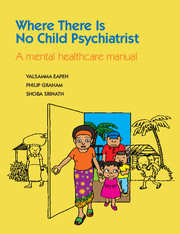Book contents
- Frontmatter
- Contents
- Preface
- Acknowledgements
- Abbreviations
- List of tables and boxes
- 1 Introduction
- 2 Assessment and treatment: general principles
- 3 Making a summary and action plan
- 4 Development and developmental problems
- 5 Intellectual disability
- 6 Habit disorders
- 7 Emotional problems
- 8 Behaviour and related problems
- 9 Specific problems in adolescence
- 10 Alcohol and drug dependency
- 11 Psychotic disorders
- 12 Chronic physical illness and disability
- 13 Physical illness without an identifiable physical explanation
- 14 Stressful situations
- 15 Parents and the needs of children
- 16 Mental health promotion
- 17 Medication
- References and suggested reading
- Appendix 1 My star chart
- Appendix 2 Guide to medication for use in childhood mental disorders
- Index
7 - Emotional problems
Published online by Cambridge University Press: 29 April 2024
- Frontmatter
- Contents
- Preface
- Acknowledgements
- Abbreviations
- List of tables and boxes
- 1 Introduction
- 2 Assessment and treatment: general principles
- 3 Making a summary and action plan
- 4 Development and developmental problems
- 5 Intellectual disability
- 6 Habit disorders
- 7 Emotional problems
- 8 Behaviour and related problems
- 9 Specific problems in adolescence
- 10 Alcohol and drug dependency
- 11 Psychotic disorders
- 12 Chronic physical illness and disability
- 13 Physical illness without an identifiable physical explanation
- 14 Stressful situations
- 15 Parents and the needs of children
- 16 Mental health promotion
- 17 Medication
- References and suggested reading
- Appendix 1 My star chart
- Appendix 2 Guide to medication for use in childhood mental disorders
- Index
Summary
Emotional problems may involve:
• excessive worrying, fear and anxiety: sometimes the fears may be focused on specific objects or situations, sometimes the anxiety may be more general. Refusal to go to school often arises from anxiety;
• excessive misery, unhappiness and depression: usually low mood is linked to a loss or other stress, but sometimes lowering of mood may appear without obvious cause. Particularly worrying features of depression are ideas of self-harming as well as acts of self-harm that may indeed be fatal;
• compulsions and obsessions: these may involve the need to check everything far more often than is necessary or carry out time-consuming rituals.
Introduction to anxiety problems
Information about anxiety problems
Anxiety is a normal human emotion. It occurs when we are faced with a real or imagined danger. It is an unpleasant sensation which we want to stop. We make it stop by dealing with the danger or by removing ourselves from the scene. We may also realise that the danger is only imaginary and there is nothing to worry about. Anxiety is necessary for us to survive as it warns us about danger and thus protects us from it.
Anxiety may present with physical symptoms such as tiredness or headaches, and mental symptoms such as irritability, inability to relax and ‘feeling on edge’. It may also present with physical or mental signs of a panic attack (see Section 7.2).
Sometimes children and adolescents experience too much anxiety which stops them from leading a normal life. When this happens they are in need of help. There are various types of excessive anxiety:
• panic attacks (see Section 7.2)
• phobias (see Section 7.3)
• school refusal (see Section 7.4)
• separation problems (see Section 7.5)
• excessive shyness (see Section 7.6).
In addition, sometimes children and adolescents feel anxious generally. Examples include:
• worries about how good they are at school or at a particular sport, about examinations or sporting competitions
• excessive self-consciousness and the need for reassurance
• restlessness, nervousness, inability to relax
• physical symptoms, such as tension, light-headedness, heart beating fast, stomach discomfort and dizziness when there is no physical reason why these should be present
• difficulty concentrating
• irritability.
- Type
- Chapter
- Information
- Where There Is No Child PsychiatristA Mental Healthcare Manual, pp. 52 - 69Publisher: Royal College of PsychiatristsPrint publication year: 2012
- Creative Commons
- This content is Open Access and distributed under the terms of the Creative Commons Attribution licence CC-BY-NC-ND 4.0 https://creativecommons.org/cclicenses/



